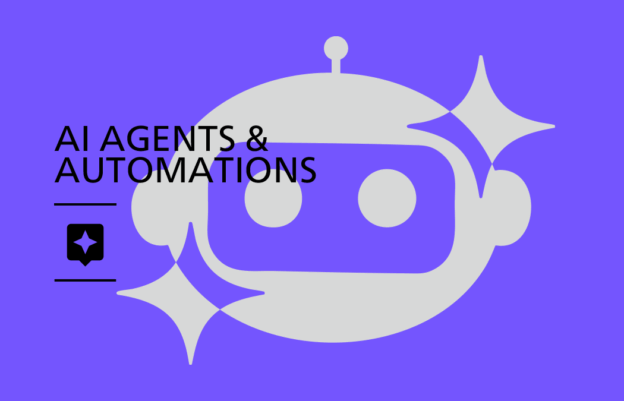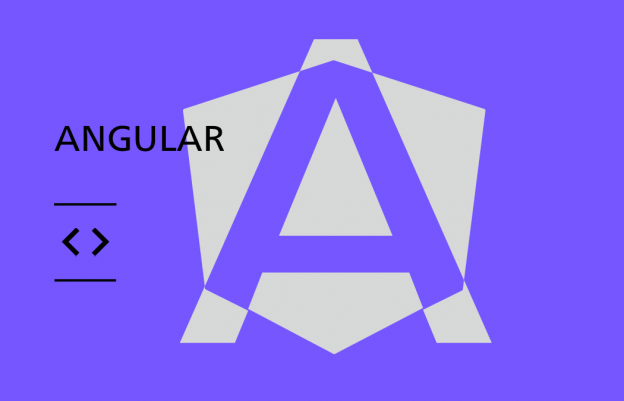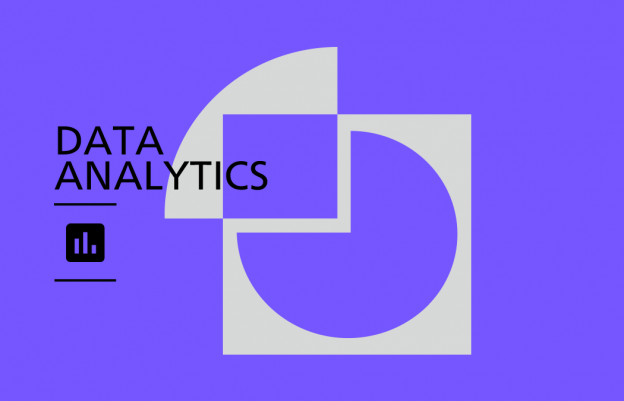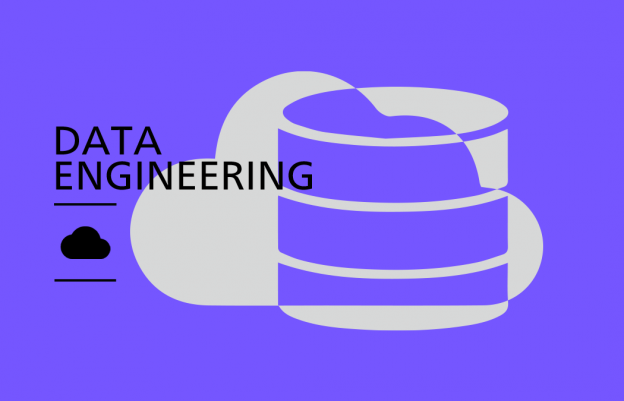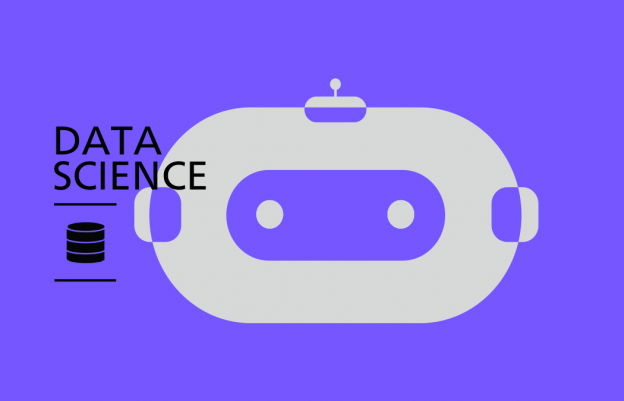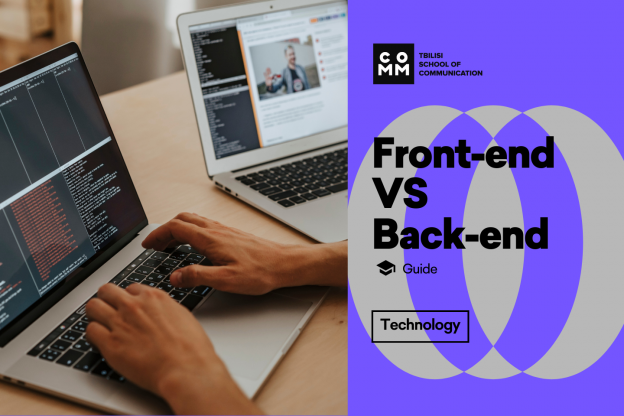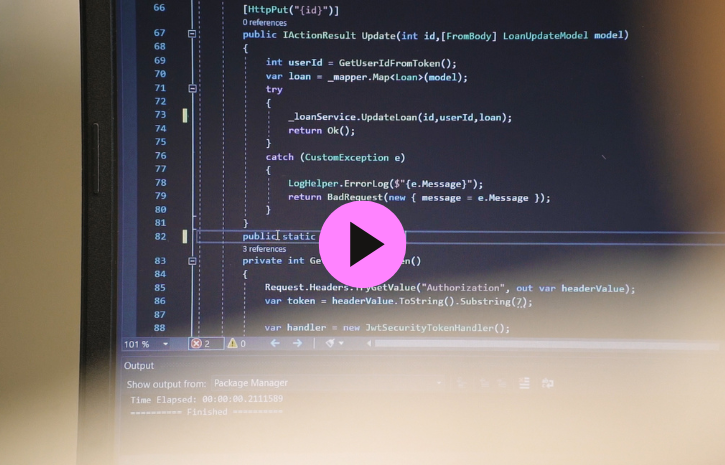
The program is entirely based on practice-oriented learning, during which students will have the opportunity to gain real project creation experience. Throughout the course, students will work with authorization modules, databases, familiarize themselves with all four principles of OOP, and Clean Code writing practices along with design patterns and SOLID principles. The program includes mentorship and Knowledge transfer sessions, which will be based on C#, one of the TOP five programming languages for Back-end according to LinkedIn.
At the end of the course, participants will create an individual project on the .Net Framework, undergo an interview simulation with live coding, which will be as close as possible to real selection stages. Finally, upon successful completion of the course, they will be ready to start a career as a Junior .Net Developer.
Outcome
Skills Acquired: c#, .Net, MS Visual Studio, MS SQL Server.
-
Apply computer science theory in practice
-
Apply software development fundamentals in practice
-
Use C# as a programming language independently
-
Create small and medium-sized applications independently on .Net 7
-
Work independently with databases
-
Use Microsoft Visual Studio
-
Use Microsoft SQL Server
-
Create and work with WEB API
-
Choose the best approaches and standards when developing applications
Mon-Thu | 20:00-23:00
 TBC installment
TBC installment
 BOG installment
BOG installment
Who is this course for?

Complete Beginners
The course is designed for people who want to learn programming and Back-end Development based on C# from scratch.

Beginner Developers
For beginner developers who have minimal knowledge in programming and want to develop further.
Program includes
Alumni Club
After successfully completing the final exam, graduates will be automatically enrolled in the Alumni Club. This membership grants them access to exclusive events, content, and special offers from our partner companies.
Work Based Learning
The course includes practice-based learning, including assignments/exercises and individual projects.
Bilingual Certification
Upon successful completion of the course, students will receive a bilingual certificate.
Graduate feedback
Syllabus
Pick your suitable time
Lecturers
Artur Zakhariani
Introduction to Programming
Artur Zakhariani
Introduction to Programming
Artur has 5 years of experience in WEB Development and currently holds the position of .Net developer at DataArt. During this period, he has worked on both international and local projects with companies such as TBC Pay and Credo Bank. Artur's experience includes creating banking-financial, insurance, and ERP applications. Throughout his career, he has primarily been involved in Back-end development using the .Net Framework. For the last few years, he has continued working as a Full Stack developer, responsible for both Back-end and Front-end operations. Artur also works on Cloud Native applications and takes on DevOps responsibilities, which include creating, optimizing, and configuring AWS services and Docker containers.
 Linkedin
Linkedin
FAQs for this course
Your search Digital Designer did not match any documents
Unable to locate relevant information?
Get Free consultationYou may interest
Relevant Resources
Show MoreData Engineering: Profession, Skills, Career Path
The vast amount of data is changing the principles of doing business and also creating a demand for data engineers who can collect, store, and sort it. It's expected that by 2025 we will produce 463 exabytes of data daily. Processing information of this scale will be impossible without industry specialists. Therefore, data engineering will become an important part of future global changes. If you work in programming and want to be part of a challenging process, read the blog and find out what opportunities data engineering offers. What does data engineering involve? Data engineers work on designing and creating systems that collect, process, and transform primary data into usable information for data scientists and business analysts. Their main goal is to make data accessible in such a way that the organization can use it to evaluate and optimize business.This is an incomplete list of responsibilities you might have when working with data:Collecting databases that relate to business needsDeveloping algorithms that transform data into practical informationBuilding, testing, and maintaining the system architecture of databasesCollaborating with managers to understand company goalsCreating new methods and tools for data validation and analysisEnsuring compliance with data management and security policies Why should you choose data engineering? Working in this field is both enjoyable and challenging. You will play an important role in the company's success. You achieve this by making data easily accessible to data scientists, analysts, and decision-makers. They need this information in their daily activities. For this, you will need programming and problem-solving skills. As long as data exists, there will be a demand for data engineers. Moreover, according to a 2019 study, data engineering is the trendiest job in the technology industry. It leaves behind computer scientists, web designers, and database architects In addition, data engineering is a high-paying profession - according to 2022 statistics, the average income in the US is $115,176.To become a successful data engineer, it's desirable to have relevant knowledge and skills in computer science. This will create the foundation needed in this rapidly developing field. If you have a bachelor's degree in computer science, then you can study data engineering at the master's level. However, it's possible to master this profession without continuing studies in higher education institutions. For this, 4 stages need to be passed: Develop skills needed for data engineering At the initial stage of your career in data science, learn the basics of cloud computing, coding, and database design. Specifically:Collecting databases that relate to business needsDeveloping algorithms that transform data into practical informationBuilding, testing, and maintaining the system architecture of databasesCollaborating with managers to understand company goalsCreating new methods and tools for data validation and analysisEnsuring compliance with data management and security policiesWhy should you choose data engineering? Working in this field is both enjoyable and challenging. You will play an important role in the company's success. You achieve this by making data easily accessible to data scientists, analysts, and decision-makers. They need this information in their daily activities. For this, you will need programming and problem-solving skills.As long as data exists, there will be a demand for data engineers. Moreover, according to a 2019 study, data engineering is the trendiest job in the technology industry. It leaves behind computer scientists, web designers, and database architects.In addition, data engineering is a high-paying profession - according to 2022 statistics, the average income in the US is $115,176.To become a successful data engineer, it's desirable to have relevant knowledge and skills in computer science. This will create the foundation needed in this rapidly developing field. If you have a bachelor's degree in computer science, then you can study data engineering at the master's level. However, it's possible to master this profession without continuing studies in higher education institutions. For this, 4 stages need to be passed:Develop skills needed for data engineering At the initial stage of your career in data science, learn the basics of cloud computing, coding, and database design. Specifically:Coding: Programming languages are essential for data engineering. Therefore, be sure to learn and develop coding skills. Useful programming languages in this field are SQL, NoSQL, Python, Java R, and Scala.Databases: They are most often used when solving data storage problems. Accordingly, you should be well acquainted with its working principles.ETL (Extract, Transform, Load) systems: This is the process when you transfer data from databases and other sources to one repository, for example, a Data Warehouse. The following tools are used for this: Xplenty, Stitch, Alooma, Talend.Data storage: Not all types of data are stored in the same way, especially when it comes to large amounts of data. When working on solving this problem for a company, you need to understand well, for example, when to use a Data Lake and when to use a Data Warehouse.Automation and scheduling: Automation is an essential part when working with a large database, for which you should be able to write a plan to perform repetitive tasks automatically.Machine learning: This topic is of interest to data science, but it will help you understand the basic principles. It will also show you the need for specialists in this field in the team.Big data tools: Data engineers mostly have to work with large amounts of data. Tools and technologies are constantly evolving. Among them, the most popular are Hadoop, MongoDB, Kafka.Cloud computing: Today, companies are replacing physical servers with cloud services. Therefore, studying this issue well will definitely be useful.Data security: Data engineers often have to work on securely storing data and protecting it. Accordingly, this skill will be needed in daily activities. Take a data engineering course Obtaining a certificate will be proof of your skills to employers. Therefore, study data engineering in a certified course and gain relevant knowledge and practical experience. This will help you refine and improve the necessary skills.Here I'll also tell you new news - you can now study data engineering at Commschool! If you know the Python programming language, then this program will interest you. Together with a professional lecturer in the field, you will learn to use key technologies and tools for data engineering, design web services for data, and various Python libraries. So, be sure to check out the course syllabus. Data Engineering 33 Lecture/ 99 Hour / 17 Week Learn More Create a portfolio In the job search process, a portfolio is often a decisive component, as it best shows your capabilities Therefore, create a web page portfolio of data engineering projects that you have completed independently or as a final course assignment. Place them on your LinkedIn profile or GitHub. tart working in an entry-level position Many data engineers start their careers in entry-level positions such as business analyst or database administrator. When you gain experience, acquire new knowledge and skills, you can also get employed in higher positions. Thus, if you see yourself in this field, take this opportunity and start learning data engineering at Commschool! Join Us
Career Guide: Become a Data Engineer
Every day we receive, process, and analyze a large amount of data, which helps us make decisions. This process is particularly important for companies. They use data to evaluate and optimize their business. A data engineer plays a significant role in this, whose responsibility includes building systems necessary for collecting, storing, and processing large amounts of information.If you want to pursue a career in data engineering, then you must read this blog. Here you'll get advice on how to become a successful data engineer. According to the International Data Corporation, by 2025 we will collect 175 zettabytes (10^21 bits) of data (for comparison, this year's figure is 33 zettabytes). How will companies manage to store and process information of this scale? The answer is: by hiring many data engineers. The reason for this is that they need more people "on the front line" to collect numerous primary data from various sources. Their main responsibility is to ensure that teams from different departments of the organization can seamlessly analyze the data they need and use it for multiple purposes. Data engineers use ETL channels to group information and make it clearer and more understandable for the entire company. How in-demand is the profession of a data engineer? In 2020, the number of vacancies announced for the position of data engineer increased by 40%. For comparison, this figure was only 10% for data scientists. For this reason, data engineer has become the fastest-growing technology profession, with demand increasing year by year. In addition, today many companies are replacing physical servers with cloud services, so the need to hire more data engineers is very high to provide significant assistance to the data science team. As for income, this direction also occupies one of the leading positions in this regard. The skills required for data engineering are quite well-paid. For example, in the USA, the average annual income is $115,157. So if you're planning to change professions and choose a new career path, now is the best time to step into this field. Data Engineering Program 33 lectures / 99 hours / 17 weeks Learn more about the course Now I'll tell you how to become a successful data engineer and what skills you'll need for this: Interest in data-driven decision making To start working in this field, you must have the desire to learn a new and challenging job Working with data and using it to draw correct and valuable conclusions and assumptions is one of the most useful skills today. In this process, you may encounter problems that require more effort from you. But if you have a strong will for this, you will definitely overcome existing obstacles. Ability to use SQL and DBMS systems Database Management Systems (DBMS) are software systems used to store, retrieve, and analyze data. A data engineer is responsible for creating them and performing actions using various tools. The most common tool among them, which is more popular than Python and R, is SQL (Structured Query Language). Therefore, study this tool well and its usage techniques, commands, and syntax. Knowledge of a programming language Data engineers use programming in their daily activities. Accordingly, you should know at least one language - Java or Python.This role involves data analysis using statistics and graphs, for which Python and other programming languages are often used. Therefore, I advise you that if you don't already know one of them, start learning it and gain practical experience. Knowledge of cloud computing basics As I've already told you, companies are actively starting to use cloud services. Data engineers will be involved in this process. Among cloud service platforms, there are three main competitors: Amazon Web Services (AWS), Google Cloud Platform (GCP), and Microsoft Azure. If you want to continue working in this direction, devote time to learning the basics of cloud computing. Work on projects that will teach you how to effectively use the listed platforms to solve real problems. Data storage and ETL techniques Creating effective ETL/ELT channels is important for every organization to store large amounts of information in an organized way. To achieve this, data engineers use various tools, for example, Snowflake, Star. Knowledge of these is an essential skill for your successful career. Ability to work with big data We live in an information age and produce and process numerous bits of data daily. There are many tools to work with big data: Spark, PySpark, Hive. You'll need to learn techniques for using them and have practical experience to work with large databases. Knowledge of new tools This field is constantly evolving and many new instruments are being created that help data engineers perform various types of tasks. For example, Snowflake for data storage, dbt for ELT, Airflow for orchestration. To keep up with the processes and changes in the industry, keep an eye on the news and learn to use such tools. Data Engineering - About the Course In parallel with mastering and improving the skills listed above, you can enroll in a data engineering course, which will better introduce you to this field and help you improve your knowledge and gain practical experience. Successfully completing the course and receiving a certificate will definitely help you in the job search process - it will give you an advantage over your competitors. Now I have good news for you - a data engineering course is starting at Commschool! The program is designed for those who have already learned the Python programming language and are interested in working with data. In the course, you'll study concepts related to data engineering, practical tools and technologies, work on an individual project, and receive career support from Commschool.So, get acquainted with the course syllabus in more detail and join us at Commschool! Learn More
Front-end vs Back-end - A Guide to Web Development
When you search for something on Google, you get several choices as a result. With each click, these results change appearance according to our wishes, and we receive a beautiful, functionally sound feedback. We know these results as websites, and their creation is known as Web development. The term web development sounds familiar because it is one of the most trendy skills you can acquire in the IT field.Web development is one of the most important parts of IT because it creates a bridge between the user and the provider. Moreover, through functionality, it helps us automate complex tasks. Front-end and Back-end are integral parts of web development. What are these parts? How do they differ from each other? How much does the functioning of a website depend on them? Does one of them stand higher than the other? If you're interested in the answers to these questions, you've come to the right place, because in this blog you'll learn about the importance and functions of Front-end and Back-end. What is Front-end? As the name suggests, Front-end is what the user sees, connects with, and experiences. It mainly includes those parts of websites and applications that are visible to the user. The person who works on this is known as a Front-end Developer. The job of a Front-end developer is to create designs using user interface and experience. The primary skills of a Front-end developer include knowledge of HTML, CSS, JavaScript, as well as frameworks such as Angular JS, Node.js, etc. Along with this, experience in version control systems such as GIT and GITHUB is important. A Front-end developer is an integral part of web development because they ensure the creation of the necessary structure for the work to be performed. What is Back-end? Back-end development resembles the backstage of a movie or show. Actions performed by the user are analyzed and sent back through codes written by the back-end. The person who develops this is known as a Back-end Developer. The main work of a Back-end Developer involves connecting all aspects to databases and the Front-end. The primary skills of a Back-end Developer include knowledge of languages such as C#, Python, Java, Ruby, etc. Back-end is very important because it gives purpose and functionality to the beauty of an application or website. Characteristics of Front-end Along with a wide range of functions, Front-end has many characteristics: Client-side rendering: It allows developers to render the entire website on the user's browser using JavaScript. Server-side rendering: It makes it possible to visualize sites directly in users' browsers based on changes requested by the users themselves. Optimization: Refined adjustment of HTML, CSS, and JavaScript ensures fast loading of sites for users. Characteristics of Back-end Like Front-end, Back-end is also equipped with many functions that are useful for developers: Databases: Stores data needed for the user. Website architecture: It involves understanding the goals needed to create an application. Scripting: Involves correct formatting of the construction. API: Application Programming Interface or API are tools that involve communication between technologies and provision of necessary data. Front-end Development Languages HTML: Hypertext Markup Language or known as HTML, is a markup language used in building web pages. The language contains elements that provide the basic layout of the website. Along with giving structure to websites, it also displays images or visuals. Its advantages are: ease of use, support for multiple browsers, and combination with other languages. Its disadvantages are: static nature, security, and huge pile of codes.CSS: Cascading Style Sheets or CSS resembles the interior design of a website. CSS is simple because the language more or less includes basic English. Its advantages include multiple browser support, simplicity, and speed. Its disadvantages include cross-browser bugs and it's also tiring for beginners.JavaScript: JavaScript is the most important and popular language of Front-end development. It provides flexibility and responsiveness to the website. Advantages include: simple nature, speed, and additional or extended functionality such as creating dialog boxes, forms, pop-up windows, etc. Disadvantages are: difficulty in debugging and browser support. However, JavaScript is also used in the back-end.Elm: Elm is a simple language used to create fast and continuous websites.SASS: SASS is another scripting language like CSS. SASS has unique features that give users a seamless experience. Advantages include: reusability and clear codes. Disadvantages include: finding problems and solving them.jQuery: jQuery is a JavaScript library that enhances HTML event handling and animations. It's very concise and reduces the number of lines of written code. Front-end Frameworks Vue.js: This is a framework built around JavaScript and is used to create compact web applications.AngularJS: It's a web framework built around JavaScript. It provides features for HTML templates and increases performance.React: This is a popular JavaScript framework that enhances user interface components and provides a dynamic nature to web applications. Back-end Development Languages Python: Python is a widely used back-end development language. Its advantages are: huge collection of libraries, easy-to-read codes, integrations, versatility, etc.PHP: This is another widely used language in back-end development. Its features include: security, platform compatibility, object-oriented programming features, and integration with databases.Java: This is widely used to create Android and desktop applications. Its features include: automatic memory allocation, portability, and one-time compilation.Ruby: Ruby is a general-purpose language that has features such as a large standard library, flexibility, scalability, etc. Back-end Frameworks Django: ეს არის მაღალი დონის ვებ ჩარჩო, რომელსაც გააჩნია ჩაშენებული დანამატები. ის საუკეთესოა ფართომასშტაბიანი, მონაცემზე ორიენტირებული, ინტერაქტიული ვებ აპლიკაციებისთვის. თუმცა, ის არ არის რეკომენდებული მცირე ზომის პროექტებისთვის.Flask: Flask არის მიკროჩარჩო, რომელიც დაფუძნებულია პითონის ენაზე. მას არ სჭირდება ბიბლიოთეკები ან ხელსაწყოები და, შესაბამისად, შესაფერისია მცირე პროექტებისთვის.Ruby on Rails: Ruby on Rails არის ვებ აპლიკაციის ჩარჩო, რომელიც დაწერილია Ruby ენაზე. იგი გამოიყენება მონაცემთა ცხრილის უნაკლო ფორმირებისა და მიგრაციის შემუშავებაში. მარტივი შედგენა და ტესტირება მისი დამატებითი უპირატესობაა.CakePHP: CakePHP არის პოპულარული ვებ ჩარჩო PHP-სთვის. იგი გამოიყენება როგორც მცირე, ისე დიდი აპლიკაციების შემუშავებაში, რადგან უფრო ადვილია კონფიგურაცია და უზრუნველყოფს სრულ უსაფრთხოებას. განსხვავება Front-end და Back-end Development-ს შორის Django: This is a high-level web framework that has built-in add-ons. It's best for large-scale, data-oriented, interactive web applications. However, it's not recommended for small-scale projects.Flask: Flask is a micro-framework based on the Python language. It doesn't need libraries or tools and, therefore, is suitable for small projects.Ruby on Rails: Ruby on Rails is a web application framework written in Ruby. It's used in developing flawless data table formation and migration. Simple compilation and testing is its additional advantage. CakePHP: CakePHP is a popular web framework for PHP. It's used in developing both small and large applications because it's easier to configure and provides complete security.Difference between Front-end and Back-end Development Front-end is the interactive part of a website or application. The graphical user interface (GUI) allows users to perform actions according to their wishes. Users can see and connect with the Front-end. Users cannot see the backstage of the website or application, i.e., the Back-end. It collects information from users, processes it, and ensures the functioning of the application.A Front-end developer works on layout, while a back-end developer's job is to achieve the functional stage.Front-end developers should have an idea about Back-end. Thus, its development is not just about beauty. Although back-end development mainly concerns logic, calculations, servers, APIs, and testing, collaboration and data exchange between front and back developers is very important. So, as you can see, web development is an interesting field in the technology sector. Front-end Development resembles the exterior of a house; paint, wall carvings, wall hangers, or everything a person can see and feel. Back-end resembles the electrical supply, building materials that you can't see, but are crucial for the house. These two things together give an application the best appearance and functionality. Learn About commschool Courses
 Beginner
Beginner  Live-online
Live-online

 Intermediate
Intermediate 